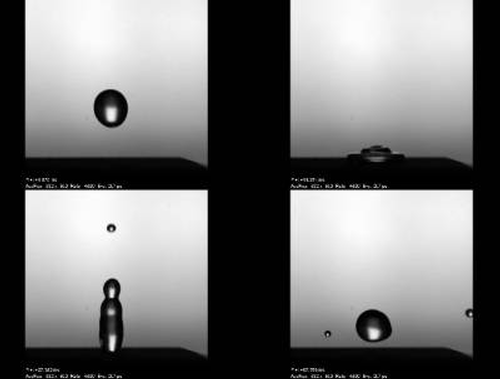Nanocomposite Coating Exhibits Icephobic Properties
TUESDAY, MARCH 29, 2022
Researchers from the Institute for Materials Discovery at the University College London recently developed a nanocomposite-based, superhydrophobic coating to limit ice formation in industrial applications.
The study, authored by Yandbei Hou and Kwang Leong Choy, was recently published in the journal Progress in Organic Coatings.
Icephobic Coating Research
According to the study, developing superhydrophobic or icephobic coatings is significant in limiting ice formation. The team notes that recent investigations focus on scientific research, but not practical application.
To solve this, the team designed and fabricated nanocomposite-based superhydrophobic PVDF-HFP/SiO2/CNTs coatings. These coatings reportedly exhibited “exceptional” water repellency at a contact angle up to 168 degrees and slide angle lower than 2 degrees.
The anti-icing performance of the coatings was “excellent,” with ice formation on aluminum film delayed by more than 300 seconds at -19 C. Researchers created equipment designed to investigate the placement orientation of the coated sample’s anti-icing performance.

 |
| University College London |
|
Researchers from the Institute for Materials Discovery at the University College London recently developed a nanocomposite-based, superhydrophobic coating to limit ice formation in industrial applications. |
Additionally, the nanocomposite coating reportedly has “superior” deicing characteristics, with ice adhesion strength testing lower than 10kPa so that it can be detached naturally from wind or its own weight.
According to UCL’s website, the anti-icing coatings research is ongoing, with two goals in mind:
- To develop and manufacture anti-icing coatings based on a) surface textured/treated coatings and b) nanocomposite coating concepts in order to obtain the desired anti-icing properties; and
- To establish the relationships between the surface topography/chemical compositions of anti-icing coatings and the thermal/mechanical interaction of coatings with ice.
The research team has reportedly fabricated adherent and uniform nanocomposite coatings (about 2µm thick) onto Al-alloy foils, with the fabricated nanocomposite coatings showing superhydrophobic properties.
Additionally, the coating on the Al-alloy foil was easily removed from the substrate, with modification improving scratch resistance on a physically modified substrate up to 8 mN and a chemically modified substrate up to 30 mN. The team reports additionally that the optimization of the nanocomposite formulation further improved scratch resistance up to 250 mN in a current test, with no failure observed at 50 mN.
“The research carried out on the development of anti-icing/de-icing nanocomposite coatings is well underway towards the development of a suitable solution,” writes UCL.
The university says that applications of these coatings could be included in aviation, naval and automotive industries and Arctic oil and gas exploration. A patent has reportedly been submitted to the U.K. Intellectual Property Office.
Recent Iceophobic Coatings
In November, Zentek Ltd., a Canadian development and commercialization company, announced the development of its new carbon-based, nanotechnology-enhanced icephobic coating.
Tests for adhesion strength required to dislodge ice from surfaces were conducted with a third-party lab, with the coating reportedly demonstrating an adhesion strength consistently around 20 kilopascals. Zentek reported at the time that the typical ice adhesion strength of a bare aluminum alloy is about 500 kilopascals, while a classified icephobic surface must be less than 100 kilopascals, with the coating having a 96% improvement over aluminum and 80% improvement over the 100 kPa threshold.
Earlier this month, the company reported the “excellent” results of testing conducted on its icephobic coating. These tests included real-world testing, drone testing and accelerated age testing.
The next rounds of testing will include testing the coating for sand and rain erosion. Zentek reports that it is also planning tests to evaluate the coating as part of a hybrid ice protection system alongside a heated deicing system to improve efficiency.
According to the company, these tests are already scheduled and results will be reported once they are available.
“Positive results from our ongoing icephobic testing, in laboratory as well as real-world conditions, clearly demonstrate the significant potential for graphene and other nanomaterials in advanced materials development and commercialization,” added Dubé.
“More specifically, we believe our icephobic coating can be used to enhance safety and efficiency in many ways, creating several potentially new opportunities for our company and shareholders.”
In January, a research team from the Skolkovo Institute of Science and Technology (Skoltech) in Moscow tested hydrophobic coatings and their effectiveness combined with other anti-icing systems.
Researchers at Skoltech then decided to test the surface wettability of aluminum in aircraft skin and see if it affects the performance of these fluids.
Three different types of fluids, which satisfied aerospace standards SAE AMS1424 or AMS1428, were tested. Each fluid type, including Type I, II and IV had different endurance times. Aluminum plates were sanded, polished and coated with a hydrophilic transparent, glossy or matte acrylic varnish.
In contrast to a Canadian team’s findings, they discovered that plate wettability had no impact on the performance of anti-icing fluids, but attribute this finding to the surface tension and viscosity of anti-icing fluids. Researchers also noted that surface roughness could play a role, since rough surfaces take longer to accumulate ice.
According to Skoltech, the study showed that the accumulation of liquid in the surface texture reduces the water-repellent properties of hydrophobic coatings.
“We think smooth hydrophobic coatings are better than rough superhydrophobic coatings when it comes to treatment with anti-icing fluids,” Viktor Grishaev, PhD, a senior research scientist at Skoltech and RSF grant project manager, commented.
Tagged categories: Coating Materials; Coatings technology; Coatings Technology; Colleges and Universities; icephobic; Nanotechnology; Research; Research and development







